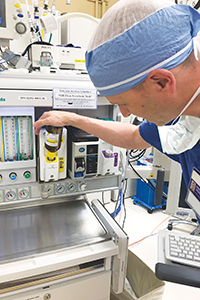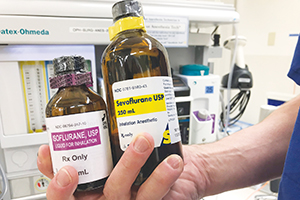By COLLEEN SCHRAPPEN
Providence Portland Medical Center has been out front in the greening of health care. The hospital has been recognized by Practice Greenhealth for superior performance in environmental sustainability. Even against that high bar, Dr. Brian Chesebro's efforts have stood out.

Dr. Brian Chesebro is working to reduce the carbon footprint of surgical anesthesia gas emissions.
Courtesy of Providence Health & Services
Chesebro, a physician with Oregon Anesthesiology Group who recently added the role of medical director of environmental stewardship for Providence Oregon to his portfolio, has made it a mission to educate fellow anesthesiologists and health professionals about the carbon footprint of anesthesiology gases.
"It's been known for about the last 10 or so years that these agents were potent greenhouse gases," Chesebro said of anesthesia gases. "But the information was not widely broadcast through the anesthesiology community."

Chesebro
He himself learned more about it a couple of years ago while he was assessing his personal carbon footprint. He found his biggest imprint was made in the operating rooms at Providence Portland Medical Center.
Most anesthesiologists use one of two gases during surgeries: desflurane or sevoflurane. Patients who are put under metabolize 5 percent of the gas when they inhale. The rest is exhaled into a ventilation system and makes its way outdoors.
Most doctors start their careers using one or the other and stick with their choice out of habit. Chesebro said the two gases are mostly interchangeable, but there is a major difference between desflurane and sevoflurane when it comes to the environment. The former is 25 times more damaging to the atmosphere, trapping much more of the sun's energy and punching well above its weight as a greenhouse gas.

Isoflurane and sevoflurane are commonly used in surgeries at Providence Portland Medical Center.
According to a 2015 study published in Geophysical Research Letters and reported by ScienceDaily, a pound of desflurane is equivalent to more than 2,800 pounds of carbon dioxide in terms of greenhouse warming potential. Though it represents a miniscule percentage of all global-warming gases, desflurane is more potent, pound for pound, in its harmful effects, scientists said.
Yale School of Medicine anesthesiology and epidemiology professor Dr. Jodi Sherman told ScienceDaily that health care is one of the worst polluting industries, generating up to 10 percent of U.S. greenhouse gases. "It behooves us to do a better job with emissions," she said.
Simply put
After learning of the residual potency of desflurane, Chesebro decided the best approach to reducing emissions was through education.
He has a pretty big megaphone, with more than 270 physicians in his private practice group. Providence Portland Medical Center, where he works, is one of eight Providence hospitals in Oregon. Providence St. Joseph Health, the system parent, has 51 hospitals and 1,085 clinics and surgery centers in seven states. Chesebro's efforts have been featured on National Public Radio and CNN.
Jean Marks, public relations manager for the medical center, said that in his new role as medical director of environmental stewardship, Chesebro will continue his anesthesia practice part-time. He will assess and manage programs throughout Providence Oregon intended to reduce the environmental impact of hospital operations overall. "In addition, he will work to improve the resiliency of our communities as we adapt to the evolving health challenges associated with environmental change," she said.
Chesebro has shared his data on the carbon footprint of anesthesia gases with colleagues one on one and in presentations to groups of 2,000 hospital managers.
"Most people were surprised," he said. "They said, 'I had no idea,' or 'I knew there were differences, but I never appreciated how different they were.' In some cases, anesthesiologists made the switch from desflurane overnight.
"This has been written about in academic medical journals. I translated the academic into a resonant argument for real-world, day-to-day anesthesiologists."
One of his most effective tools has been a slide showing the environmental consequences of an anesthesiologist who treats patients with desflurane. Most doctors assume their greatest area of impact happens outside of work. In fact, it's the opposite. In this example, emissions from the anesthesiologist's house, car and air travel comprise 10 percent of his environmental footprint. The other 90 percent stems from the use of desflurane.
Chesebro uses hospital data from electronic medical records and pharmacy receipts to determine how much the desflurane costs in dollars and in emissions. He can separate the usage numbers for each individual anesthesiologist.
"This isn't this nebulous problem. It strips away the anonymity. Everyone is held accountable for their own performance. It's very effective for motivating change," he said.
Voluntary changes
"Brian's work has had a huge impact on our ministries in Oregon and is beginning to spread across all of Providence St. Joseph Health," Lisa Vance, executive vice president and chief executive of Providence Health & Services — Oregon Region, said in an email.

Vance
"He did a lot of work to pull data, and then spent time talking with each doctor to show them their usage and explain how using different anesthesia gas would make a difference. For anesthesiologists who practice in our hospitals, nearly all of them have changed their practice."
Some hospitals, such as Yale New Haven Hospital, have imposed a ban on desflurane. Chesebro said, based on the voluntary changes he has seen, a mandate is not necessary within Providence Oregon.
"We try to avoid that kind of decision because it disempowers physicians," he said. "Based on what we've seen in Oregon, it's not necessary. People are feeling really engaged and excited about making sustainable choices."
Over the past 18 months, there has been an 80 percent drop in desflurane usage in Providence Oregon hospitals. Desflurane costs 2.5 times as much as the usual alternative, sevoflurane, saving the system $500,000 annually.
The savings are significant, Vance said, but not the primary focus. "Providence St. Joseph Health believes this is part of our mission, and something we are called to do — to be wise stewards of our resources."
Chesebro pointed to the "double involvement" of the health care industry in global warming: "We're contributors to the problem, and we're called on to care for people suffering the health effects of climate change … It hits the poor and vulnerable the hardest, and that's who we're called to care for in a mission-driven health system like Providence."
He cited Pope Francis' 2015 encyclical on the environment, Laudato Sí: On Care for Our Common Home, as connecting care for the environment with faith and social justice.
Said Chesebro, "He doesn't shy away from it, and I don't think we should, either."